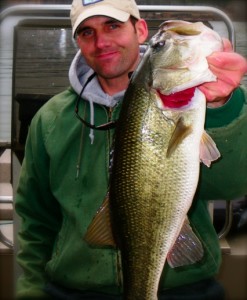 Chesapeake Light Tackle readers are sure to recognize the striper techniques I recommend as little more than modified methods for catching freshwater bass. I have little use for the heavy trolling gear or live bait most Chesapeake Bay fishermen feel they need to be successful. A bass is a bass and it’s a lot easier to land a 40 pound striper in the unobstructed open water of the Bay than it is to land a 5 pound smallmouth in heavy cover. Since I’ve concentrated so intently on striper fishing over the past four years, I’ve felt like I might be getting a little behind the freshwater bass fishing curve. Let’s just say my street cred has been slipping with the freshwater bass crowd. So, when my wife offered me a week-long opportunity to fish anywhere I wanted as a birthday gift, my choice of venues came easy. Instead of marlin fishing in the mid-Atlantic, trout casting in the northwest, or redfish chasing in Florida, I chose large and smallmouth bass fishing near my old haunts in the Tennessee Valley. Read More!
Chesapeake Light Tackle readers are sure to recognize the striper techniques I recommend as little more than modified methods for catching freshwater bass. I have little use for the heavy trolling gear or live bait most Chesapeake Bay fishermen feel they need to be successful. A bass is a bass and it’s a lot easier to land a 40 pound striper in the unobstructed open water of the Bay than it is to land a 5 pound smallmouth in heavy cover. Since I’ve concentrated so intently on striper fishing over the past four years, I’ve felt like I might be getting a little behind the freshwater bass fishing curve. Let’s just say my street cred has been slipping with the freshwater bass crowd. So, when my wife offered me a week-long opportunity to fish anywhere I wanted as a birthday gift, my choice of venues came easy. Instead of marlin fishing in the mid-Atlantic, trout casting in the northwest, or redfish chasing in Florida, I chose large and smallmouth bass fishing near my old haunts in the Tennessee Valley. Read More!
![DSC_0177[1]](http://www.chesapeakelighttackle.com/wp-content/uploads/2010/09/DSC_01771-300x242.jpg) Don’t tell me the moon is shining
Show me the glint of light on broken glass – Anton Chekhov
Don’t tell me the moon is shining
Show me the glint of light on broken glass – Anton Chekhov
The full moon that occurs closest to the autumn equinox (the first day of Fall) is called the Harvest Moon. It gets the nickname because there is bright moonlight from before sunset to almost sunrise so there is plenty of nighttime light for activities such as gathering crops. It’s also one of the best moons for fishing the Chesapeake Bay. I pay very close attention to the phases of the moon. Not only do they tell me a lot about water levels and the intensity of expected currents, they also provide information about fish behavior. Striped bass feed at night. While you aren’t likely to see younger Chesapeake stripers blitzing under the full moon, the big girls are usually on the prowl beneath bright night skies. I like to fish after dark during the spring and fall. By now you’ve likely read my recent reports about the great shallow-water action we’ve had this year. Nothing gets my blood boiling like nice fish blowing up on top-water plugs in less than a foot of water. For the past month or so shallow-water stripers have been extremely active in the late afternoon hours. The shore-side feeding frenzy usually begins around 5:00 PM and builds to a crescendo before turning off just after sunset. Things pick back up just before sunrise and continue until the day gets bright. This week, thanks to the full harvest moon, all bets are off. As you can see in the video, the shallow bite is wide open though both daylight and dark. Read More!
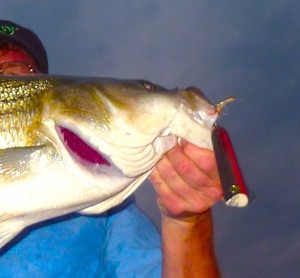 On a recent trip to my family farm in Eastern Tennessee I was rummaging though my dad’s old workshop and came across some lures he worked on. After dad passed in 1999, my brothers and I shared a lot of his fishing gear, but there was too much to take it all. During his busy lifetime that included fishing, managing bait shops and running boat docks, he collected a lot of stuff. For as long as I remember my father was a lure maker. Some of my earliest memories include opening the door to his shop and being blasted by the smothering fumes of burnt worm plastic. I still have scars from when I disobeyed, got too close to the melting pot and got splattered by hot lead. Sometimes I wonder how I’ve lived to be fifty years old considering all the chemicals I was exposed to as a child. (I also used to chew lead sinkers instead of bubble gum, but that’s another story.) Even though some of those lure making memories aren’t too pleasant, finding the old cedar blanks he started made me smile. Read More!
On a recent trip to my family farm in Eastern Tennessee I was rummaging though my dad’s old workshop and came across some lures he worked on. After dad passed in 1999, my brothers and I shared a lot of his fishing gear, but there was too much to take it all. During his busy lifetime that included fishing, managing bait shops and running boat docks, he collected a lot of stuff. For as long as I remember my father was a lure maker. Some of my earliest memories include opening the door to his shop and being blasted by the smothering fumes of burnt worm plastic. I still have scars from when I disobeyed, got too close to the melting pot and got splattered by hot lead. Sometimes I wonder how I’ve lived to be fifty years old considering all the chemicals I was exposed to as a child. (I also used to chew lead sinkers instead of bubble gum, but that’s another story.) Even though some of those lure making memories aren’t too pleasant, finding the old cedar blanks he started made me smile. Read More!
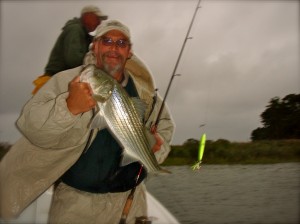 Fall is coming fast to the Chesapeake region bringing changing patterns in fish behavior. This is the time when resident Bay rockfish move shallow and start feeding heavily in order to put on winter weight. While there are still active fish in the open waters over the oyster bars and around the mid-Bay islands, the real fun is close in to the shore; so close in fact that you really don’t need a boat. A kayak or even waders are more appropriate this time of year, the only challenge being access to the best fishing spots. It’s tough to get most center console style fishing boats in tight enough to shore. Many light tackle anglers compromise by going with a bay style boat. That’s a good idea, but since I also fish the big water in the worst of the winter, I prefer a larger ride with a steeper deadrise. Due to the savvy design skills of Eastern Shore boat builder Bill Judge, I feel like I have the best of both worlds. Thunder Road, my 2010 Judge 27 CC only draws about 16 inches. I’ve put all 16 to use and then some over the past couple of weeks while working the grass beds of Talbot and Dorchester counties. Check out the video below and you’ll see what I mean. Read More!
Fall is coming fast to the Chesapeake region bringing changing patterns in fish behavior. This is the time when resident Bay rockfish move shallow and start feeding heavily in order to put on winter weight. While there are still active fish in the open waters over the oyster bars and around the mid-Bay islands, the real fun is close in to the shore; so close in fact that you really don’t need a boat. A kayak or even waders are more appropriate this time of year, the only challenge being access to the best fishing spots. It’s tough to get most center console style fishing boats in tight enough to shore. Many light tackle anglers compromise by going with a bay style boat. That’s a good idea, but since I also fish the big water in the worst of the winter, I prefer a larger ride with a steeper deadrise. Due to the savvy design skills of Eastern Shore boat builder Bill Judge, I feel like I have the best of both worlds. Thunder Road, my 2010 Judge 27 CC only draws about 16 inches. I’ve put all 16 to use and then some over the past couple of weeks while working the grass beds of Talbot and Dorchester counties. Check out the video below and you’ll see what I mean. Read More!
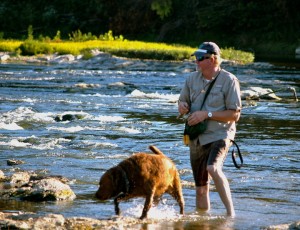 Top-water fishing in the mid-Bay shallows has been nothing short of amazing lately, but I’ve had other pursuits in mind. This past weekend was not a good time to fish the Chesapeake Bay. Sailors, cruisers, tourists, kayakers, fishermen and excursionists of all kinds flock to the Bay by the thousands for Labor Day’s last long taste of sweet sweet summer. This week, there’s a hint of fall in the air. Local marinas are running winterization specials as many boaters put their rides away until next spring. Early flocks of migratory waterfowl are taking flight toward the south. The Spanish mackerel are high-tailing it toward the capes. The female ospreys are almost gone while the smaller males make a few final dives before starting their trans-continental journey toward the Amazon. For many, this is a depressing time of year, but for the light tackle angler it’s the start of the most productive season of all. To celebrate the impending fall and avoid the holiday crowds, I like to head north toward the mountains. The green flash of a smallmouth bass leaping into the blue sky out of a sparkling stream is more spectacular than any Labor Day fireworks. Read More!
Top-water fishing in the mid-Bay shallows has been nothing short of amazing lately, but I’ve had other pursuits in mind. This past weekend was not a good time to fish the Chesapeake Bay. Sailors, cruisers, tourists, kayakers, fishermen and excursionists of all kinds flock to the Bay by the thousands for Labor Day’s last long taste of sweet sweet summer. This week, there’s a hint of fall in the air. Local marinas are running winterization specials as many boaters put their rides away until next spring. Early flocks of migratory waterfowl are taking flight toward the south. The Spanish mackerel are high-tailing it toward the capes. The female ospreys are almost gone while the smaller males make a few final dives before starting their trans-continental journey toward the Amazon. For many, this is a depressing time of year, but for the light tackle angler it’s the start of the most productive season of all. To celebrate the impending fall and avoid the holiday crowds, I like to head north toward the mountains. The green flash of a smallmouth bass leaping into the blue sky out of a sparkling stream is more spectacular than any Labor Day fireworks. Read More!
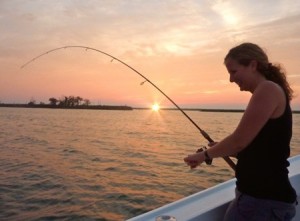 I’ve collected a number of sunset photos over the past eight or nine days. As water temperatures begin to fall, stripers are moving into shallower water where they can find cover while chasing bait. I’ve been setting our drifts over humps in the 4 to 5 foot range in the flats around Kent, Poplar, and Tighlman Islands. While almost any kind of top-water lure will work, I prefer Lonely Anglers, Stillwater SmackIts, and Heddon Super Spooks. The fish can bite anytime, but they always turn on right about the time the sun hits the western horizon. There have been a few birds working in the shallows, but some of the most successful trips have just been blind-casting over structure. Any area where the bottom comes up a foot or more over the surrounding flat can hold fish. Aquatic grass is a plus. Good water quality is essential. So is flowing current. That’s been somewhat hard to come by lately. Hurricane Earl has made its way past the mouth of the Chesapeake and up the Atlantic Seaboard with very little impact on our region except for a disruption in the normal tidal patterns. I’ve been compensating by Read More!
I’ve collected a number of sunset photos over the past eight or nine days. As water temperatures begin to fall, stripers are moving into shallower water where they can find cover while chasing bait. I’ve been setting our drifts over humps in the 4 to 5 foot range in the flats around Kent, Poplar, and Tighlman Islands. While almost any kind of top-water lure will work, I prefer Lonely Anglers, Stillwater SmackIts, and Heddon Super Spooks. The fish can bite anytime, but they always turn on right about the time the sun hits the western horizon. There have been a few birds working in the shallows, but some of the most successful trips have just been blind-casting over structure. Any area where the bottom comes up a foot or more over the surrounding flat can hold fish. Aquatic grass is a plus. Good water quality is essential. So is flowing current. That’s been somewhat hard to come by lately. Hurricane Earl has made its way past the mouth of the Chesapeake and up the Atlantic Seaboard with very little impact on our region except for a disruption in the normal tidal patterns. I’ve been compensating by Read More!


